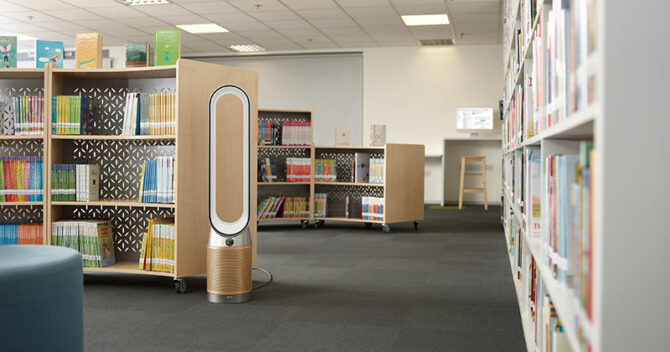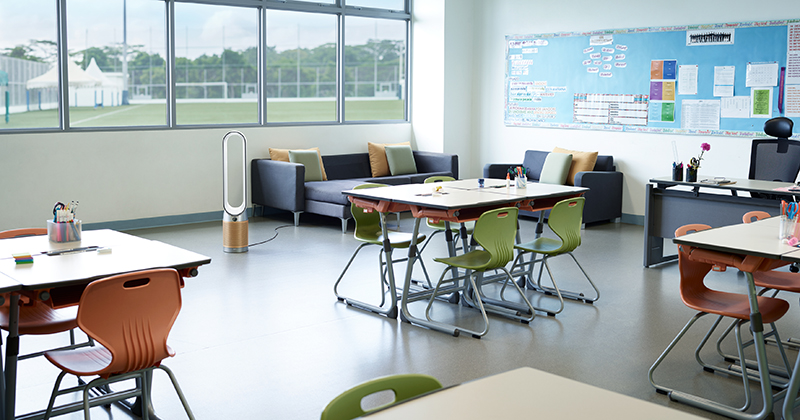With another school holiday on the horizon, many children will be breathing a big sigh of relief. But is it time to take a step back and consider just how clean the air they’re breathing actually is?
Understanding the impact of air pollution behind closed doors
When we talk about air pollution, many of us will conjure up images of being outside. You may picture a big factory billowing smoke onto the street, or remember holding your nose while walking along a busy road to avoid the smell of traffic fumes. Perhaps less on our radar, however, is the types of air pollution we can be exposed to indoors.
According to the findings from a UK study, indoor air pollution can be up to 5 times worse than outdoor air pollution, and at its peak, can also be up to 560 times higher.[1],[2] With another survey showing that many countries can spend as much as 90% of their time indoors, it is clear that we need to start shifting the focus to more carefully consider the air being circulated behind closed doors.[3]
Not only can indoor environments potentially trap outdoor pollution and viruses, many day-to-day activities carried out inside can create pollution in their own right. Typical types of pollution found indoors include PM10, PM2.5, VOCs, and NO2. While we have some control over our activities at home, and can proactively make better decisions to improve air quality, public indoor areas like workplaces, schools, and leisure spaces often take this choice out of our hands. As a result, we are reliant on those in charge of running the space or building to put suitable solutions in place to protect our wellbeing.
Putting classrooms top of the agenda
Since the classroom is an area where most children spend over a quarter of their day, five days a week, managing its air quality should therefore be top of the agenda for school leaders and caretakers. To make sure indoor educational spaces are suitably ventilated, the Department for Education (DfE) announced their approval of Dyson HEPA Cool™ Formaldehyde air purifying fans, offering 9,000 air purifiers to state-funded primary and secondary schools.
Air pollution in the classroom can come from a range of sources. One potential source is volatile organic compounds (VOCs) which can come from building materials, cleaning products, and certain types of paint, specifically formaldehyde which is a colourless gas pollutant. Carbon dioxide (CO2) levels can also be higher in a classroom setting due to there being lots of children in one enclosed space, highlighting the importance of good air ventilation. In this respect the Government is already taking some positive steps forward – its recent rollout of CO2 monitors, for example, will allow staff to quickly identify where air quality needs to be improved.
As we come to the end of another term, it’s important to look at what changes can be made for the months ahead, to help support the wellbeing of children in education settings. Facilities managers and school leaders are key in implementing new technologies and strategies to improve indoor air quality, and this should remain top of mind even into the new year. So, what can be done to help tackle indoor and outdoor pollution in schools and help everyone to breathe cleaner air?

Taking it to the next level
While the obvious solution to indoor air pollution is opening windows and doors to achieve better ventilation, this may not always keep outside pollutants out of the classroom.
Only ventilating a room by opening the windows can affect the temperature inside, causing discomfort and possibly distraction to students. What’s more, with pollen season and exam timing often overlapping, students can be left struggling with allergy symptoms at a crucial time.
Although there isn’t a universal solution to improving air purity indoors, there are several things school leaders can do to get a handle on pollution levels and help minimise their potential impact in the classroom. Here are our top three tips at Dyson for Business:
- Educate and build awareness
The first step to solving any problem is education. Those working in schools need to help build awareness by talking more openly about indoor air pollution. For example, many staff may not be aware that potential outdoor pollutants and pollen can come in through open windows and affect the comfort of students. It is also important to encourage staff at all levels to play a role in monitoring air quality levels indoors and open up the dialogue about ways of increasing adequate ventilation wherever possible.
- Review existing equipment
Many schools could be using HVAC systems, which can contain hydrofluorocarbons (HFCs). [4] These gases can have a detrimental impact on the ozone layer and contribute to the climate crisis. On top of this, HVAC systems often do not filter pollutants out of the air effectively.[5] Now could be the time to review your current equipment and check if it needs an upgrade.
- Consider purchasing new equipment
Finally, implementing purifiers around schools can help to create a more comfortable educational environment. The Dyson HEPA Cool Formaldehyde, for example, helps to capture 99.95% of particles as small as 0.1 microns from the air through its 360° HEPA H13 filter. Thanks to the powerful circulation it generates, over 290 litres of air is projected throughout the room per second. This means that particles like VOCs are removed from the air, helping those in the classroom to breathe better.
Dyson in partnership with Rexel, are working with the Department for Education to offer air cleaning units to education settings: https://www.rexel.co.uk/uki/dfe-information
To find out more how Dyson technology can support cleaner, more comfortable educational environment visit our education page here: https://www.dyson.co.uk/commercial/overview/education
[1] European Respiratory Journal, October 2012 [LAST ACCESSED: 23.11.21]
[2] RCP Working Party Report, 2016 [LAST ACCESSED: 23.11.21]
[3] EPA, The Inside Story: A Guide to Indoor Air Quality [LAST ACCESSED: 08.11.21]
[4] CCA Coalition, Hydrofluorocarbons (HFCs) [LAST ACCESSED: 23.10.21]
[5] Nature, January 2020, Increase in global emissions of HFC-23 despite near-total expected reductions, [LAST ACCESSSED: 27.10.21]
















Your thoughts